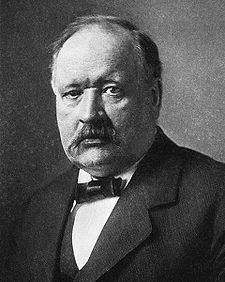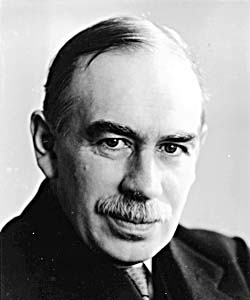Tweet ![]() During the Great Depression the Classical Economists said “Unemployment is voluntary. Business owners will not voluntarily keep the means of production idle.” While he had been a student of classical economics, John Maynard Keynes observed that the data didn’t fit the theory. And, he reasoned, if the observable data don’t fit the theory, the theory must be flawed. “Business owners are risk averse,” he saw. “A employee needs to be productive, needs to make widgets. But if no one is buying widgets, then contrary to classical theory, factory owners will fire workers and keep capital idle rather than hire workers to create excess inventory. That’s just common sense.”
During the Great Depression the Classical Economists said “Unemployment is voluntary. Business owners will not voluntarily keep the means of production idle.” While he had been a student of classical economics, John Maynard Keynes observed that the data didn’t fit the theory. And, he reasoned, if the observable data don’t fit the theory, the theory must be flawed. “Business owners are risk averse,” he saw. “A employee needs to be productive, needs to make widgets. But if no one is buying widgets, then contrary to classical theory, factory owners will fire workers and keep capital idle rather than hire workers to create excess inventory. That’s just common sense.”
We see this today.
When unemployment was low, for example in the United States during the tech boom of the 1990’s, people acted on the premise that “There is so much work that we could hire and good people and train them.” Today hiring managers seem to be acting on the premise that “There are so many people looking for work that they can wait for the perfect candidate.” Perfection being unattainable, jobs go unfilled. This is ok, in this context, because
- “Budgets are tight.”
- “The future is uncertain.”
- “Money not spent on a new hire can be saved or used to pay down debt.”
Keynes also observed that the government is an employer that does not need to worry about going out of business. Building infrastructure is government employment that is investment for the future. These observations are as valid today as they were 80 years ago.
Back to the problem of today’s unemployment, we also see hiring managers faced with dozens, perhaps hundreds, of qualified applicants, including many who are out of work, and many who are “over-qualified.” Suppose a hiring manager has 100 resumes. Each has two pages and a one-page cover letter. At one minute per page, it would take 300 minutes – 5 hours – to read the resumes and cover letters. Assuming half are qualified applicants, and the hiring managers throws darts, he or she has a 50/50 chance of finding someone good. While no one with integrity would do that; HR must read resumes and talk to people on the phone trying to send the hiring managers a reasonable number of the best resumes. The level of specialization in today’s world makes the job harder. If someone talks slowly in a phone interview are they thoughtful, looking up the answer on the Internet, or stupid? Again, with 20 or 50 new resumes each day, why not wait? HR and hiring managers may say “these applicants seem to be really good, but are they? let’s see who else is out there.”
The decision to hire the employer closes the door to all other candidates. If the new employee doesn’t work out, which may not be evident for 3 to 6 months, the employer has to fire the employee – which costs time and money, and and then go thru another round of search, weed out, and ultimately hire. From the employer’s perspective the biggest risks are that the prospective employee is either incapable of doing the job, as advertised on the resume, or unwilling to do the job, and as promised in the sales call that is the interview.
But let’s take a step back. Let’s look at the economy from 30,000 feet, or 10,000 meters, and look thru the lens of “sustainability.” Consider what our competitors in other countries are doing. Every developed country except the United States has a single payer health care system which covers every citizen and even tourists. A high speed rail system links people in Europe from Madrid to Rome, Paris, Berlin, Vienna, Amsterdam, and London. Germany is replacing their nuclear plants – which 10 years ago provided 29% of their electricity and today provide 20% – with clean, renewable, sustainable energy from wind, solar, and combined cycle hydro and biofuel systems. What about a domestic high speed rail infrastructure efficiently linking cities from Boston to Miami, New York to San Francisco, LA to Seattle (and Vancouver) and Chicago to Denver to Dallas, Houston, Austin, Reno, LA, and Mexico?
Can we do this? How long would it take? How much would it cost? What is the multiplier? How many jobs would be created? We have 14 or 15 million unemployed people, millions others who have been out of work so long that they are not counted, and countless more who are underemployed! How many jobs would we create building a sustainable energy infrastructure and a high speed rail infrastructure? With wind turbines offshore of the East Coast in up and down the Great Plains and solar modules on the roof of our homes, schools, office buildings, stores and factories? And with insulation and cogeneration basically doubling building energy efficiency? Can we retrain unemployed coal miners in manufacture of solar modules, mounting systems and wind turbines? The answer is of course. The questions that matter are “How much would it cost?” and “Can we afford not to?”
 In the last 210 years we – humanity – have increased atmospheric carbon dioxide from 290 parts per million and about 2.8 trillion tons to 390 ppm and 3.6 trillion tons. Looking at the data Arrhenius concluded that increasing carbon dioxide in the atmosphere would make summers warmer in Scandinavia. He was right. However, we now know that burning fossil fuels contributes to storms, floods, the death of coral reefs and the challenged food supply of climate change. We also know that domestic oil production peaked in 1971 and international production is peaking now. Do we want to blow up every last mountain in Appalachia for coal? Do we want to destroy water supplies for methane? Don’t we realize that sooner or later we, or our children, will have to shift the energy paradigm to one that is sustainable? And beyond that, fuel free energy systems cost less. While this actually hurts GDP – GDP measures spends not value – repair of the damages caused by the earthquake – tsunami – nuclear disaster at Fukushima (IAEC Log) and the Deepwater Horizon will contribute to GDP – but these decrease Genuine Progress Index (wiki). These are ‘Uneconomic Growth.” Fuel free energy systems contribute to the Genuine Progress Index and other indices that measure wealth and happiness.
In the last 210 years we – humanity – have increased atmospheric carbon dioxide from 290 parts per million and about 2.8 trillion tons to 390 ppm and 3.6 trillion tons. Looking at the data Arrhenius concluded that increasing carbon dioxide in the atmosphere would make summers warmer in Scandinavia. He was right. However, we now know that burning fossil fuels contributes to storms, floods, the death of coral reefs and the challenged food supply of climate change. We also know that domestic oil production peaked in 1971 and international production is peaking now. Do we want to blow up every last mountain in Appalachia for coal? Do we want to destroy water supplies for methane? Don’t we realize that sooner or later we, or our children, will have to shift the energy paradigm to one that is sustainable? And beyond that, fuel free energy systems cost less. While this actually hurts GDP – GDP measures spends not value – repair of the damages caused by the earthquake – tsunami – nuclear disaster at Fukushima (IAEC Log) and the Deepwater Horizon will contribute to GDP – but these decrease Genuine Progress Index (wiki). These are ‘Uneconomic Growth.” Fuel free energy systems contribute to the Genuine Progress Index and other indices that measure wealth and happiness.
